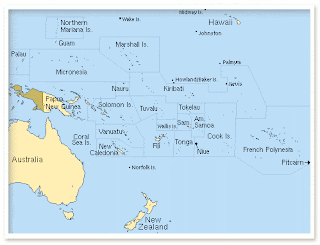Bringing new cases, the age will share the truth & knowledge. Depicting the endless corruption, debt, hate, control and battle that is conditioned into our everyday lives. It will exist for the years 2010 to 2020 (The information age). It will be as even sided & independent as possible as we go through the greatest transition age of power & energy the human race has ever experienced
"The world, nor the universe is a small place, its 1 natural consciousness aware of itself"
Thursday, 13 December 2012
CASE 431 - The history of the Pacific Islands
The Pacific Islands comprise 20,000 to 30,000 islands in the Pacific Ocean and are mainly owned or colonized by the British, US and the French. The islands are also sometimes collectively called Oceania, although Oceania is sometimes defined as also including Australasia and the Malay Archipelago.
Three of the major groups of islands in the Pacific Ocean. The Pacific Islands lying south of the tropic of Cancer are traditionally grouped into the three divisions of Melanesia, Micronesia, and Polynesia: Melanesia means black islands. These include New Guinea (the largest Pacific island and second largest island in the world after Greenland, which is divided into the sovereign nation of Papua New Guinea and the Indonesian provinces of Maluku, Papua and West Papua), New Caledonia, Zenadh Kes (Torres Strait Islands), Vanuatu, Fiji, and the Solomon Islands.
Micronesia means small islands. These include the Marianas, Guam, Wake Island, Palau, the Marshall Islands, Kiribati, *Nauru, and the Federated States of Micronesia. Most of these lie north of the equator. Polynesia means many islands. These include New Zealand, the Hawaiian Islands, Rotuma, the Midway Islands, Samoa, American Samoa, Tonga, Tuvalu, the Cook Islands, Wallis and Futuna, Tokelau, Niue, French Polynesia, and Easter Island. It is the largest of the three zones.
The region's islands are classified into two groups, high islands and low islands. Volcanoes form high islands, which generally can support more people and have a more fertile soil. Low islands are reefs or atolls, and are relatively small and infertile. Melanesia, the most populous of the three regions, contains mainly high islands, while most of Micronesia and Polynesia are low islands. In addition, there are many other islands located within the boundaries of the Pacific Ocean that are not considered part of Oceania. These islands include the Galápagos Islands of Ecuador; the Aleutian Islands in Alaska, United States; the Russian islands of Sakhalin and Kuril Islands; Taiwan and other islands of the Republic of China; the Philippines; islands in the South China Sea, which includes the disputed South China Sea Islands; most of the islands of Indonesia; and the island nation of Japan, which comprises the Japanese Archipelago.
Nauru (along with Kiribati's Banaba island) could be counted as somewhat of an exception. The indigenous Nauruans are both a mosaic and mixture of groups from all three categories- with cultural influence stemming primarily from Micronesia. The island was also said to be an extreme point of the "Tongan Empire" and may as a result share subtle cultural and, obviously, historical aspects with Polynesia. Lastly, the people speak a language and have a number of genes not in common with any of the three regions. Of the three, Nauru is least like Polynesia and Melanesia and for practical applications, Nauru is either assigned to Micronesia or designated as a separate entity (with the former being the most common).
Subscribe to:
Post Comments (Atom)




No comments:
Post a Comment